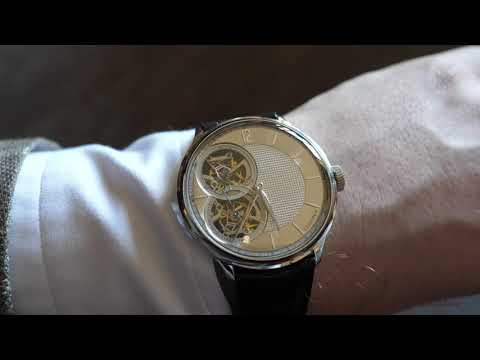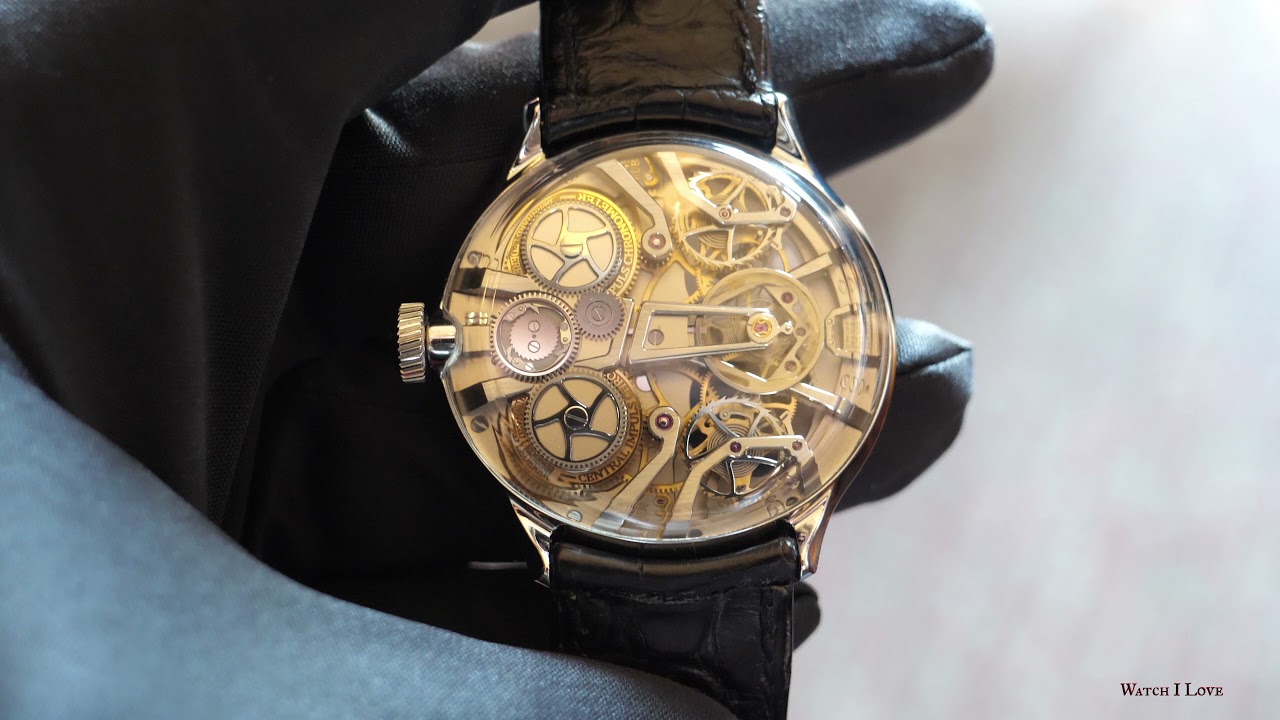Just a few days before GWD 2021, Bernhard Lederer announces the launch of the Central Impulse Chronometer. After last’s year concept release, the master watchmaker brought some cosmetic and technical changes that have a huge impact on aesthetics but also the way the escapement works.

For those interested only in the visuals, let’s start with the hands-on video. Of course, a large and detailed gallery will follow at the end of the article.
- The Big 8 Central Impulse Chronometer Rhodium

- The Big 8 Central Impulse Chronometer Dark Blue

I was very lucky last year to get to view and experience live the prototypes of the Lederer Central Impulse Chronometer that I reviewed here. This year I grabbed the chance to see the novelties with both hands. The changes are spectacular in all perspectives: technical and visual. Nicknamed The Big 8, the watches presented at the end of the summer kept most of the characteristics presented by the concept pieces. A few “small” changes brought a new perspective on how the escapement works and I hope I will be able, with the words of the master himself, to explain as better as possible.

A modern approach to elegance
Central Impulse Chronometer comes in the same interesting presentation as last year. The watch comes in an 18K white gold case in a subtle, elegant and very wearable ratio of 44mm diameter and 12.2mm thickness. The slender body is covered by a raised slim rounded bezel and ends with ergonomic lugs.

Viewed from the sides, the watch reveals an unexpected large crystal caseback. This approach has two main advantages: it permits a refined profile for the case and allows an unobstructed view of the mechanical wonder underneath.

The right side of the case presents a new crown, completely different from both versions seen last year. The new crown is manufactured with an angled grip and engraved “L” – logo. The new design fits well in the entire theme, contributing to The Big 8 good look.
Two dial colour variations
While I like the design of the prototypes presented last year, I was not completely convinced by it. This year, the design language evolved in complexity and value. The Lederer Central Impulse Chronometer is available in Dark Blue and Rhodium finish. Moreover, a new hand moving counterclockwise makes its presence.

The new dial comes with an exceptional guilloche pattern in the centre. An attentive look reveals the evolution in shape and size of the hobnail pattern towards any direction. This living pattern is not visible on a first glance but it creates an incredible attraction. It is an exceptional choice to counterpart the rest of the rich details.

The inner pattern is surrounded by the circular brushed surface bearing slender but complex-shaped applied indexes. An exception is made for the 12 o’clock position fitted with tall Arabic numerals. An outer register has the role of displaying the minutes by using a printed track adorned with Arabic numerals for each 15th position.

The Big 8 names come from the two circles interlocked in figure eight on the left side of the dial. This part of the dial has multiple roles. It displays seconds in a clockwise and counterclockwise manner. For that, it uses two styles of markings. And to reveal through its apertures the complex double remontoir.

The top thermally blued hand displays the counterclockwise rotating seconds. Note the ten seconds remontoir mechanism and the escapement of the first gear train (yes, there are two completely separate gear trains).

The lower small seconds rotates in the classic, expected direction. This is synchronized with the top one and also shows no drift in relation to each other. This precision is also attested by chronometric certification. The mechanical interconnection is beautifully represented on the dial side by the exquisite details of the intertwined sub-dials.

For the final version, Bernhard Lederer opted for skeletonised and faceted leaf hands, in my opinion much more suitable for this elegant presence as the sporty SuperLuminova filled seen last year. The hands and the indexes are manufactured in white gold, matching the case material.

No magic, just science and innovation…
Lederer Central Impulse Chronometer has suffered some changes also on the mechanical side. Lederer Watches calibre 9012 is built using two distinctive gear trains: two barrels and two ten-seconds remontoirs working alternatively. The trains end with an innovative escapement that supplies energy to a variable inertia, 3-Hz balance wheel fitted with 4 regulating weights and 4 balancing weights.

Inspired by the 3Hz escapement of the great watchmaker George Daniels, the master continued its efforts in improving the escapement. First, the material of the components was changed from steel to titanium, decreasing the weight and increasing the robustness. The reduced weight helped, as a natural physical consequence, reducing the inertial moment. A first effect is a reduced disturbance (each component has less influence on the next: better start, better break).

Below, a gear train with remontoir in a close-up view and the frontal view. More detailed pictures are in the image gallery.
The most important piece of the Constant Impulse Chronometer is the anchor with improved geometry. To reduce the recoil of the escapement, Lederer changed completely the shape of the central pallet. A change that was thought to be impossible until now reduces drastically the contact forces, removing the recoil of the escapement wheel and creating an impulse constant in time even in low amplitude, increasing the isochronism.

Constant Impulse Chronometer escapament
To better understand the changes, I will let the master watchmaker explain in its own words.




In principle, Bernhard Lederer reshaped profoundly a detail that was thought to be already the best possible. He took a giant leap and removed a huge problem of chronometric escapements – the recoil of the escapement wheel. Below is the explanation given by Bernhard.
Start of action
The ellipse dips into the fork of the escapement metronome.
The wheel (left side) that will transmit the energy is laying on the curved “waiting-pallet”. This curved surface ensures that the escape wheel is not brought into a recoil but can immediately take up its correct direction. This means an enormous gain in time.

The “indirect impulse“
With small oscillation amplitudes, the rotary movement of the escapement metronome is so slow that the tooth that had been laying on the waiting pallet slides along our indirect impulse lifting surface and conveys an indirect impulse to the balance via the metronome, that functions in that specific moment like an anchor in the swiss lever escapement.

The end of the “indirect impulse“
From the moment the tooth is released (1) that did slide along the lateral indirect-impulse surface, it is ensured that the impulse-taking pallet (2) is safely in front of the impulse-giving tooth (3).
By adding the indirect impulse surface, we achieve that the impulse-transmitting escape wheel has already started moving before it is finally released. This significantly shortens the distance that the escape wheel would have to travel if it first had to overcome the recoil and then hurry after the impulse-taking pallet.
This invention is patent pending.

Self-starting
Another significant aspect of the patent-pending invention of the Central Impulse Chronometer is the achievement of the self-starting of this chronometer escapement.
Once the watch is completely run down, the ellipse is in a neutral middle position and keeps the escapement metronome as well in a neutral position. The shape of the waiting pallet with its additional lateral impulse surface means that one escapement wheel lays against this indirect-impulse surface and causes the balance to oscillate as soon as the escapement wheel receives again a power supply.

Such a technical marvel could not come without exceptional finished. The openworked movement reveals every detail and every detail was well been taking care of. Gears with Lederer tangential design, chamfering, polishing, brushing, sandblasting – everything skilfully executed.

Final words
I have to admit that I was not expecting to have again mind blown by the technical details of the Lederer Central Impulse Chronometer. Some cosmetic changes, yes. Maybe some new details… But a completely new approach in escapement’s geometry? Clearly not… The Lederer Central Impulse Chronometer is a highly technical piece not for everyone to understand and appreciate.

But besides that, the Central Impulse Chronometer is a gorgeous looking watch, with an elegant, even subtle presence. From the dial details to the highly innovative movement (also very good looking), Lederer presents an etalon in beauty visually and technically – because these two characteristics go hand in hand in this one. This watch is limited to 25 pieces each dial colour variation.
Bernhard Lederer has gained its place in the history of horology along Breguet and Daniels. I don’t even dare to ask what comes next…

Lederer Central Impulse Chronometer Technical Specifications
Name: CENTRAL IMPULSE CHRONOMETER
Reference: 9012
Functions: Hours, minutes, small seconds at 8 and 11 o’clock
Case:
- 18k white gold
- Diameter: 44 mm
- Thickness: 12.2 mm
- Case back: Open, sapphire glass with anti-reflective coating
- Water resistance: 3 ATM
Dial:
- Guilloché (exclusive Lederer motif) with two circles interlocked in a figure eight.
- Available in two colours, rhodium and dark blue.
Movement:
- Mechanical, hand-wound
- Number of components: 210
- Number of jewels: 45 rubies
- Frequency: 21,600 vibrations per hour (3 Hz)
- Diameter: 39.3 mm
- Thickness: 5.98 mm
- Special features:
- Two barrels
- Two independent gear trains
- Two constant-force remontoirs
- Two escapement wheels with central impulses
- Power reserve: 42 hours
- Finishing:
- Frosted with hand-bevelled bridges,
- wheels with circular graining and hand-bevelled spokes,
- steel parts black polished.
Winding & setting:
- Two-position winding stem:
- Position 1: manual winding
- Position 2: setting the time


























































Exquisite
Yes, indeed! ?